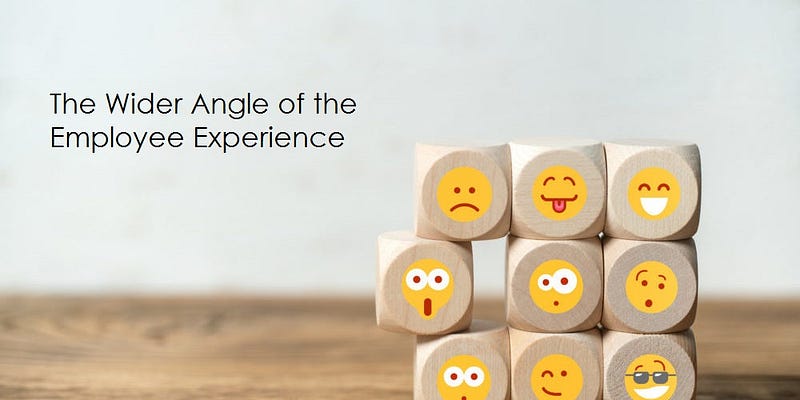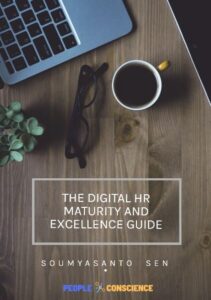Employee experience is not only a top priority for organizations today. As digital thinking is transforming our consumer habits and experiences in respect to every interaction we have with a person, product, place, service or company, the employee experience — which is defined by various moments — is gradually becoming an expectation from the workforce.
Human experiences can be thought of as a series of intimate, meaningful, precious and natural moments and while we remember some moments for a long time, others just expire quickly. Not every memorable moment is a happy moment either, as moments are not created equal, and the ones that make us feel stressed, frustrated, scared or helpless, have a negative impact on our lives.

This should also be true for the experiences and moments created for employees in organizations. As per a Gartner Research, the employee experience can be defined as ‘an employee’s perceptions and related feelings originated by either one or cumulative effects of interactions with their organization’s customers, leaders, teams, processes, policies, systems, and work environment.’
These memorable moments for the employee can be both positive or negative. It could be, for example, being discriminated against at work or getting injured at work and it could also be about taking maternity leave or being promoted. Although some memorable moments matter most for employees, not all employees have the same moments that matter. The above-mentioned Gartner analysis states that across several employee segments, such as age, gender, generation, and geography, there are differences in the moments that matter most for each segment.
In most cases, the employee experience summarizes all that people encounter, observe or feel over the course of their employee lifecycle journey at an organization. Today, a common misconception is that the employee experience begins when the new hire walks through the door on their first day and ends when they leave through that same door. The employee experience, however, is an extensive view of the relationship between the individual and the organization and must include the entire organizational journey; starting from the application process and continuing after being separated.
Listening to the voice of the employee only matters for designing and optimizing an employee experience when we start to think about the moments from an employee perspective, as a part of the workforce, not as an employee experience expert. So, it is vital to understand the wider angle of the employee experience and to see the big picture from an employee point of view. That’s what should matter most for organizations.
The Wider or Entire Employee Experience
Organizations must also eliminate or optimize the moments that have a negative impact on their workforce. They should aim to provide their people with positive touch-points not only at the various stages of the employee-lifecycle but also, when an employee is still just a candidate and beyond the separation process, even after becoming alumni. The experience generated from the moments that matter comes from consuming human resource functions, the actual job, and the company culture along with technology and workplace experience.

More and more companies are realizing that success depends on improving and optimizing the wider or entire employee lifecycle experience and not only a part of it. However, they may start focusing on a few of those parts first. An overview of the different components or dimensions of a wider employee experience — which can be divided into four — is shown in figure 1.
1. Candidate Experience
While the candidate experience is an often overlooked part of the employee lifecycle and considered separately, it can make a new employee’s life much easier and provide an entirely different experience when done well. It starts with attracting talent and covers the entire recruiting experience, including pre-onboarding, the period between accepting and starting a job.
In the employee experience, a potential candidate plays a huge role in overall satisfaction. Once the organization starts separating employee and candidate experience, the value starts diminishing automatically and a discriminative experience appears immediately, where moments for candidates and employees are treated differently.
2. Employee Lifecycle Experience
Every employee goes through a series of stages from the day they get selected up until the day they leave the company. This is a proven model generally applied by HR organizations around the world, known as the employee lifecycle, and it’s the most common form of employee experience most organizations focus on today. Below are the employee lifecycle stages along with their different elements.
- Hiring and Onboarding — when onboarding is considered as the experience from an employee’s perspective, the complex and uncertain process become very simple. It begins with recruitment and hiring, as applicants engage with the organization, they get an initial sense of the workplace vibe and how it operates. Organizations with an exceptional onboarding experience are more likely to attract and keep the best talents, as the moment to get started in an organization can be remembered forever, in most cases.
- Leadership and Career — employees need a clear purpose, and they want to feel like they’re part of the organization and its vision. This is only possible through clear communication from their leaders. Leadership is not about position and title, it is about the actions and examples shown by the leaders, which can literally inspire and motivate employees to keep performing and engaging in their career. Experiences with leadership are vital, as, in most of the cases, these moments affect the decisions of employees to stay or leave.
- Development and Learning — the demand for continuous learning should ensure that the workforce is always up to date, and to keep on going in their work and job. Investing in employee development and learning is not only needed for the organization’s growth and performance, it also provides a different positive experience for the workforce to get motivated and work efficiently. Moments that were created during an employee’s learning initiatives could directly reflect the decisions on their career and development plan.
- Team Building and Engagement — a good team is a group of different abilities, experiences, talents, and diversity, who come together for a shared purpose. A good moment with a team who respects each other and whose relationships are based on trust is always a fabulous experience for an individual. An employee’s satisfaction with their job, loyalty, and team is an inclination to spend an open effort toward organizational goals and creates an outstanding experience for employee engagement.
- Flexibility and Wellness — flexibility has become a modern-day value that everyone wants as a memorable moment. Flexible employees modify their approach to tasks based on the preferences of stakeholders and, the benefits of flexible working are increasing engagement and performance. A right wellbeing and wellness program gives the employee the best opportunity to be healthy, motivated, happy and successful in their job, along with valuable experience for the employee.
- Performance and Rewards — being recognized and rewarded for the efforts and performance that employees put into their work are crucial memorable moments for employees. Feeling valued at work is one of the key factors for generating engagement and showing that the organization values its employees keeps them motivated. An amazing experience is only established when an organization can provide an open, feedback-driven culture and relevant recognition at work.
- Off-boarding and Separation — a formalized offboarding process not only mitigates legal and security threats and helps you gain honest feedback from employees on where to improve your organization. It can also create space for boomerang employees to return in the future. It’s easy to get excited about bringing a new team member on board, but it’s not the same when an employee is getting separated from the organization. These moments usually linger longer, as they may hold a lot of emotions and relations.
- Growth and Mobility — competition for top talent is increasing, and so is an organizational focus on engagement and retention. Effective succession planning, opportunities for growth and a superior mobility program are an advantage for employees not only to move forward and grow but also generate an experience for the employee that matters. And these moments are always considered as a top memorable experience for an employee.
3. Alumni Experience
People no longer stay in the same job forever. This also means that your employees of today could be your customers and networkers of tomorrow. It’s a common misconception that employees who have left a company no longer have an influence on it. Alumni are among a company’s most effective means of external communication, and actively nurturing these relationships contributes immensely to a business’s success.
Therefore, an alumni experience can be a big turning point for both the workforce and the organization and should not be separated from the employee experience. And although in most cases today, this is the weakest experience for people, it is a vital one, as such moments can help with building long-term relationships, networking, and leveraging the social capital.
4. Organizational-journey Experience
There are indeed different moments being generated when employees interact with their team, bosses, workplace and experience culture. Employees build relationships with others and connect emotionally, they collaborate openly in the team and they either learn or contribute to the culture of the organization.
Employees are also quite attached to their workplaces. After all, it’s the place where they spend most of their working time, it’s where their senses are being put to work. Employees have different experiences and feelings about their jobs, the use of technology, regulation, compliance, training and many more aspects of their journey. Figure 2 shows some of the moments that matter in an organizational journey experience.

Below you’ll find the different dimensions from the organizational journey experience, where the various moments matter equally for an employee.
HR Functions Experience
The human resources organization handles many necessary functions of the business, related to people. These functions are critical because without those functions being completed, the organization would not be able to meet the essential needs of the management and the workforce. There are many such functions, apart from the employee lifecycle which creates memorable moments and experiences.
The experiences with time tracking, requesting holiday, work from home, managing sick leave and doctor’s notes, travel requests and expense management are crucial for an employee as well, as all these moments are part of their working lives. Moments that also matter are how an employee or manager is managing shifts, accessing the team calendar, and experiencing employee relations, compliances, or policies.
Job Experience
No one can work alone in their job, every task and challenge is engaged in a relationship and network, with relevant support from various tools and processes. Employees’ personal tools and applications have given them high expectations regarding their user experience. However, many business tools and supporting processes don’t live up to these expectations with complicated and complex user experiences. Moments are valuable when we deal with any relationship and it is very important to have an experience which can handle these moments regarding communication, collaboration, accessing global networks, connection with communities, or even knowing the change agents and informal leaders.
For employees, it matters to experience moments on how they access to their company info, news, contacts, offerings, lunch menu, or wellness programs and how easily they can book a meeting room, or organize a workshop, or even report an issue. The experiences they have with supporting tools and processes like in purchasing, facilities, budgeting, taxation, security or data privacy, can’t be ignored either.
Culture Experience
Although we can’t see the organizational culture directly, we can feel it in every part of our professional lives, as it centers on the concepts of values, shared assumptions, beliefs, and behaviors from individuals and teams. Culture doesn’t only concern the employees, as it starts when a candidate first comes across a company. Most of the moments that any individual generates in a company, are somehow connected with the organization’s culture and also represent that culture.
Today, employees are looking for more than perks and benefits; they constantly want to feel their contribution, even to the organizational culture. When the organization’s culture centers on positivity, effectiveness, and creativity, it creates moments for the employees that can bring value to their life and lead the organization towards success. Experiences generated from the moments related to trust, respect, openness, transparency, and relationships are important to consider for culture as well.
Technology Experience
The technology environment is all about the tools, systems, and applications that employees use to get their jobs done. Failure to provide the right use of technologies definitely hinders efficiency and changes how employees feel about the organization. Today, employees expect workplace agility and ease of use for any device. They want an improved information-sharing, collaboration, and more intuitive experience. Experiences generated from accessing the IT systems and services, WIFI capabilities or connectivity, the use of new devices, and all other digital experiences matter a lot for employees, especially since we are in a digital age. Employees also want an easy, smart process for reporting technical issues, service requests, connectivity issues, buying services and devices, security awareness and a digital skills training experience.
Moreover, the workforce does not want interactions with machines instead of the valuable human connections needed to feel a sense of belonging at work. Therefore, for nicer moments a human touch is also important, with the right balance between a digital and a human-based experience.
Workplace Experience
When organizations provide employees the right provision and resources they need to complete their work productively, along with a fun and creative environment, organizations can obtain the benefits of a healthy, happy and engaged workforce. An innovative, memorable and effective workplace can transform an organization to do their business with a higher level of success and provide an employee with much more interesting memorable moments at their work.
A good workplace experience does not come from free food, yoga, and a foosball table. It comes from moments that matter for employees generated from their experience with feedback processes, the organizational structure, commute time, bureaucracy, cubicles, etc. These workplaces should be the places where the employee’s senses are being put to work, and they are the key to creativity, collaboration, and wellness. The moments are also vital from digital workplaces, that enable new, more effective ways of working and increase employee engagement and agility in a consumer-oriented way.
For a successful employee experience design and optimization, it is important to have a good sense of an overall employee experience journey from beginning to end.
A journey map is a great tool which visually describes an employee’s journey as she or he strives to achieve a goal. It represents a timeline of the employee experience and key touchpoints; what the employee is feeling, thinking and doing; as well as pain points and opportunities. Employee journey mapping can provide a much-required clarity and help to identify the areas where one should prioritize your employee experience efforts, based on all the moments that are generated from the wider or entire employee experience.
If the employee experience matters for an organization, then they need to make sure it provides the right value to employees, and it should also care for the memorable moments that matter for an employee. If we try to understand and capture these moments, we really need to think of ourselves as an employee first. Once we do that, it becomes pretty clear that experiences come from many different moments that arise from the entire employee journey in an organization and that we need a wider angle to view the full picture.
The entire or wider employee experience is usually the sum of all types of experiences and interactions that affect an employee’s perception, behavior, and feelings. Creating an inspiring employee experience is not about providing extra benefits, perks, and usage of modern technologies. What’s important is to motivate and engage employees and to help them become better at their job; what’s important is to provide them with a great culture and leadership that inspires them to work continually and happily.


